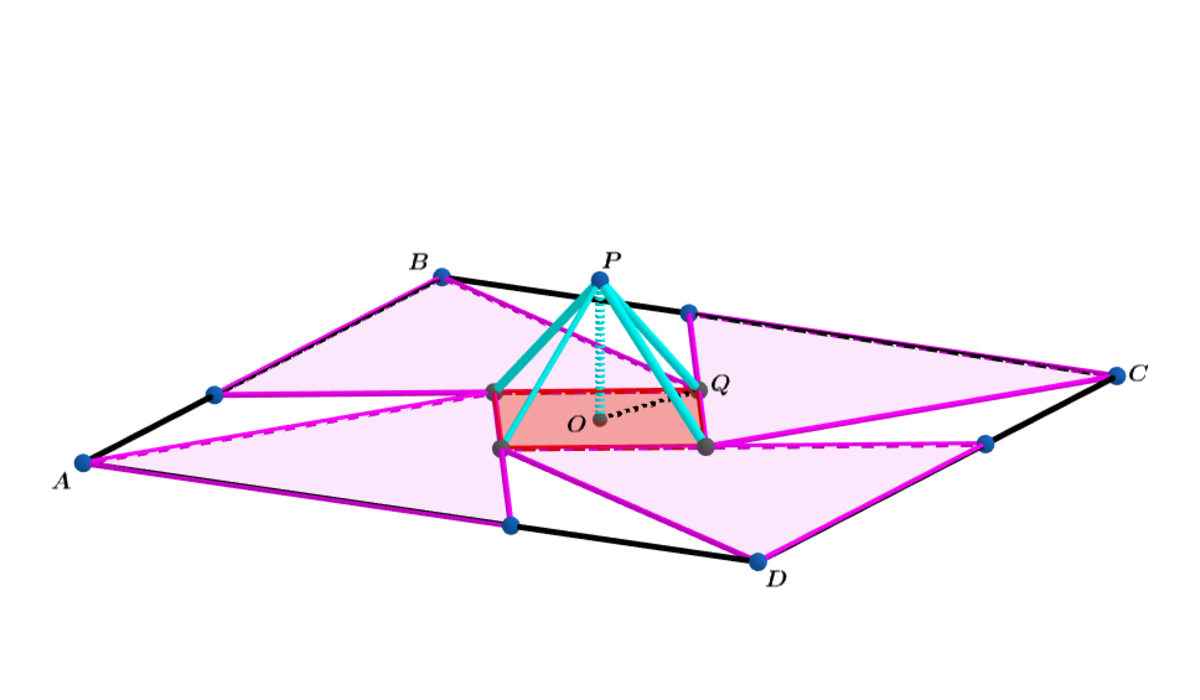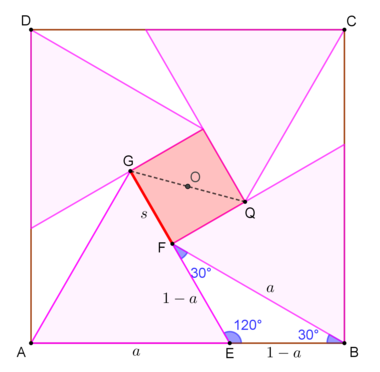Wedged in equilateral triangles 2.

In square A B C D , four congruent equilateral triangles are wedged in to form the inner red square.
Let O be the center of the red square and point Q a vertex of the red square and fold O Q at a right angle, as shown above, to form the height of the right square pyramid.
Let V p be the volume of the right square pyramid and V C be the volume of the cube formed using square A B C D .
If V C V P = λ γ ( α − β λ ) γ λ , where α , β . λ and γ are coprime positive integers, find α + β + λ + γ .
The answer is 16.
This section requires Javascript.
You are seeing this because something didn't load right. We suggest you, (a) try
refreshing the page, (b) enabling javascript if it is disabled on your browser and,
finally, (c)
loading the
non-javascript version of this page
. We're sorry about the hassle.
2 solutions
 For simplicity let
A
B
C
D
be a unit square. Then, the volume of the cube is
V
C
=
1
.
For simplicity let
A
B
C
D
be a unit square. Then, the volume of the cube is
V
C
=
1
.
Now, with the labelling of the figure where
a
is the side length of the equilateral triangles and
s
is the side length of the inner red square, we focus on
△
F
E
B
:
∠
F
E
B
=
1
2
0
∘
and
∠
F
B
E
=
3
0
∘
, hence
∠
E
F
B
=
3
0
∘
, i..e.
△
F
E
B
is isosceles, with
E
B
=
E
F
=
1
−
a
.
By sine rule, sin E F B = sin B F E ⇒ sin 1 2 0 ∘ a = sin 3 0 ∘ 1 − a ⇒ 2 1 a = 2 3 ( 1 − a ) ⇒ a = 2 3 − 3 Furthermore, s = G F = G E − F E = a − ( 1 − a ) = 2 a − 1 = 2 2 3 − 3 − 1 ⇒ s = 2 − 3 For the height h of the pyramid, h = O Q = 2 G Q = 2 s 2 = 2 s Thus, the volume of the pyramid is V P = 3 1 s 2 h = 3 1 ⋅ 2 s 3 = 3 2 ( 2 − 3 ) 3 = 3 2 [ ( 2 − 3 ) 2 ] 2 3 = 3 2 ( 7 − 4 3 ) 2 3 ⇒ V C V P = 1 V P = 3 2 ( 7 − 4 3 ) 2 3 Hence, α = 7 , β = 4 , λ = 3 , γ = 2 and α + β + λ + γ = 7 + 4 + 3 + 2 = 1 6 .
Let m be a side of square A B C D .
Let A e be the area of equilateral △ D F E ⟹ 4 A e = 4 ( 2 1 ) ( a ) ( 2 3 a ) = 3 a 2
Let A I be the area of △ G F D
The height h △ G F D = ( m − a ) sin ( 6 0 ∘ ) = 2 3 ( m − a ) ⟹
4 A I = 4 ( 2 1 ) ( m − a ) 2 ( 2 3 ) = 3 ( m − a ) 2
Using the law of cosines on △ G F D with included ∠ F G D ⟹
a 2 = 2 ( m − a ) 2 ( 2 3 ) = 3 ( m − a ) 2 = 3 a 2 − 6 m a + 3 m 2 ⟹ 2 a 2 − 6 m a + 3 m 2 = 0
⟹ a = 2 3 ± 3 m
a = 2 3 + 3 m ⟹ m − a = − ( 1 + 3 ) m < 0
a = 2 3 − 3 m ⟹ m − a = 2 3 − 1 m
∴ we drop a = 2 3 + 3 m and choose a = 2 3 − 3 m
⟹ 4 A e = 4 3 ( 3 − 3 ) 2 m 2 = 2 3 3 ( 2 − 3 ) m 2
and
4 A I = 3 ( m − a ) 2 = 4 3 ( 3 − 1 ) 2 m 2 = 2 3 ( 2 − 3 ) m 2
Let A s be the area of the red square
⟹ A s = m 2 − ( 4 A e + 4 A I ) = ( 1 − ( 2 3 ( 2 − 3 ) ) ) m 2 = ( 1 − ( 4 3 − 6 ) ) m 2
= ( 7 − 4 3 ) m 2
Let y be a side of the red square ⟹ y = 7 − 4 3 m ⟹ O Q = 2 2 7 − 4 3 m = 2 7 − 4 3 m ⟹
V p = 3 1 A s O Q = 3 2 ( 7 − 4 3 ) 2 3 m 3 ⟹
V C V P = 3 2 ( 7 − 4 3 ) 2 3 = λ γ ( α − β λ ) γ λ ⟹
α + β + λ + γ = 1 6 .